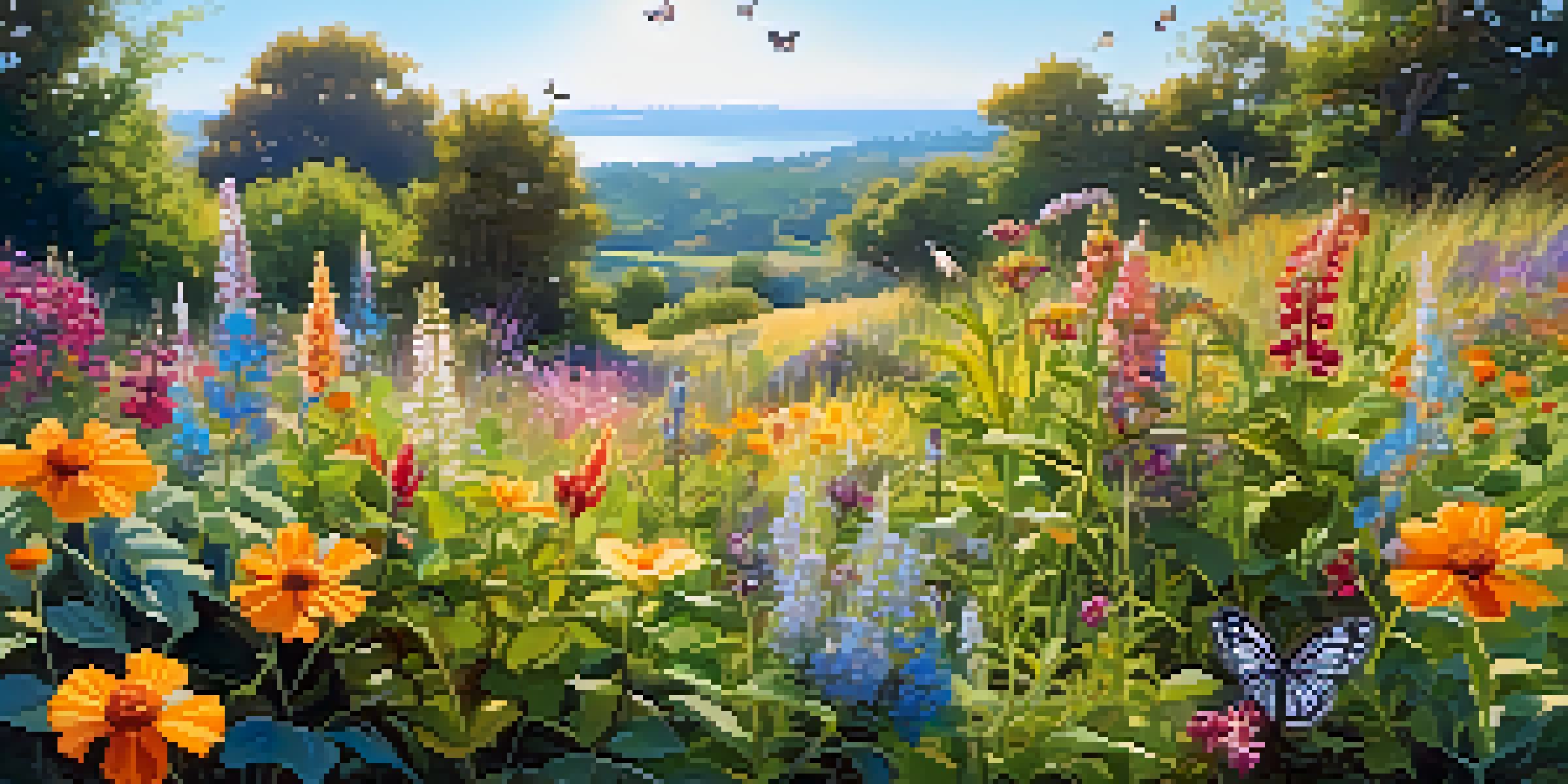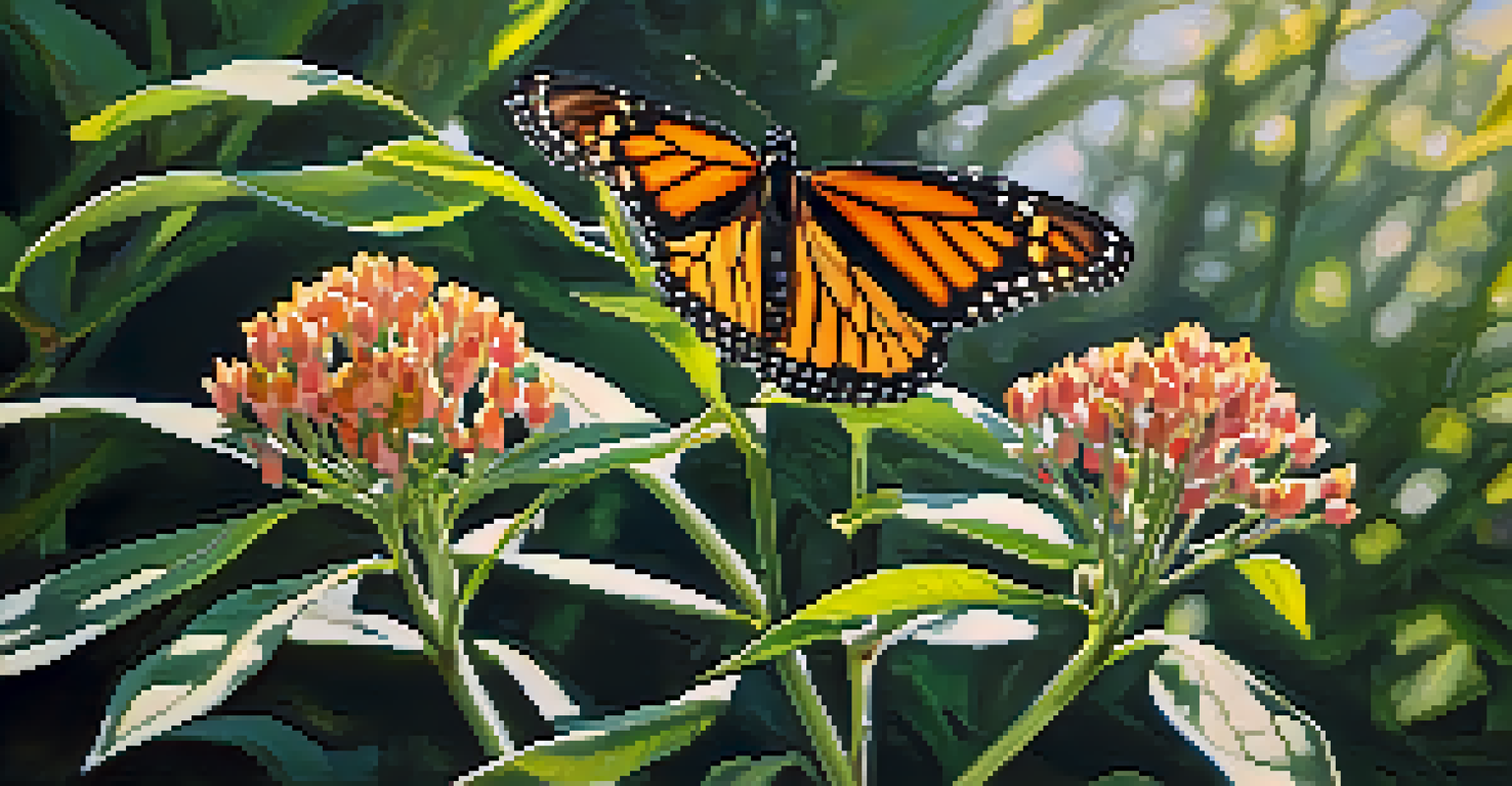The Benefits of Using Native Plants in Landscape Design

Native Plants Enhance Local Biodiversity and Ecosystems
Using native plants in landscape design plays a crucial role in supporting local ecosystems. These plants have evolved alongside local wildlife, providing essential habitats and food sources for native birds, insects, and other animals. By incorporating them into your garden, you contribute to a balanced ecosystem that thrives on local interactions.
The greatest threat to our planet is the belief that someone else will save it.
For instance, planting milkweed invites monarch butterflies, while native grasses can provide shelter for small mammals. Such interactions create a vibrant environment that showcases the beauty of local flora and fauna. This biodiversity is not just aesthetically pleasing; it also strengthens the resilience of the ecosystem against pests and diseases.
Moreover, maintaining biodiversity helps pollinators, like bees, flourish, which is vital for many crops and flowering plants. Ultimately, investing in native plants means investing in a healthier, more sustainable environment that benefits everyone.
Native Plants Require Less Water and Maintenance
One of the standout benefits of native plants is their ability to thrive in local conditions, which often means they require less water. Unlike exotic species that may need frequent watering to survive, native plants are adapted to the local climate and soil, making them more drought-resistant. This not only saves you time but also reduces your water bills.

Additionally, native plants generally require less maintenance over time. Since they are well-suited to their environment, they often resist pests and diseases better than non-native species. This means fewer interventions, such as pesticides or fertilizers, are needed to keep your landscape looking great.
Boost Local Biodiversity with Native Plants
Incorporating native plants into landscape design supports local ecosystems by providing habitats and food for wildlife.
By choosing native plants, you can enjoy a lush garden that requires less effort and resources. This makes them perfect for busy homeowners who want a beautiful landscape without the constant upkeep.
Native Plants Support Soil Health and Erosion Control
The roots of native plants are typically deeper and more extensive than those of non-natives. This helps to stabilize soil and reduces erosion, making them excellent choices for slopes or areas prone to runoff. Healthy soil plays a vital role in sustaining plant life and contributing to a balanced ecosystem.
Nature does not hurry, yet everything is accomplished.
Moreover, native plants enhance soil health by improving its structure and nutrient content. Their organic matter adds richness to the soil, which in turn supports the growth of other plants. This creates a self-sustaining environment where plants can thrive without the need for chemical fertilizers.
Incorporating native plants into your landscape design is a natural way to promote soil health. Healthy soil not only benefits your plants but also plays a crucial role in water filtration and reducing pollution.
Native Plants Attract Pollinators and Beneficial Insects
Pollinators like bees, butterflies, and hummingbirds are essential for a thriving garden, and native plants are key to attracting them. Many native species produce flowers rich in nectar and pollen, making them irresistible to these beneficial insects. This not only enhances the beauty of your landscape but also promotes healthy plant reproduction.
For example, planting a variety of native flowering plants ensures a continuous bloom throughout the growing season, providing food for pollinators from spring to fall. This diversity not only supports pollinator populations but also increases the overall health and productivity of your garden.
Low Maintenance and Water Needs
Native plants thrive in local conditions, requiring less water and maintenance, making them ideal for busy homeowners.
By choosing native plants, you create a vibrant ecosystem that supports pollinators and beneficial insects, contributing to a more resilient landscape. The result is not just a beautiful garden; it's a thriving habitat that supports wildlife and enhances biodiversity.
Native Plants Are Adapted to Local Climate Conditions
Native plants have evolved over centuries to adapt to the specific climates and conditions of their regions. This means they are more resilient to local weather patterns, whether it's heavy rains or droughts. By planting native species, you’re choosing plants that are well-equipped to thrive in your landscape without the need for extensive care.
For example, if you live in an area that experiences dry summers, native plants like succulents or drought-resistant wildflowers can flourish with minimal water. This adaptability not only promotes a sustainable landscape but also reduces stress on local water resources.
Embracing native plants means embracing a landscape design that works with nature rather than against it. This harmony between plants and their environment leads to healthier gardens and reduced maintenance efforts.
Native Plants Offer Unique Beauty and Seasonal Interest
One common misconception about native plants is that they are less attractive than exotic varieties. In reality, native plants offer a diverse array of colors, shapes, and textures that can create stunning landscapes. From vibrant wildflowers to unique foliage, these plants can add a distinctive touch to your garden.
Moreover, native plants often provide year-round interest. Many species exhibit changes in foliage color, flowering times, and even seed heads that attract birds in the winter. This seasonal variety means that your landscape will continually evolve, offering something new to admire throughout the year.
Promote Sustainability and Local Beauty
Using native plants reduces environmental impact while celebrating the unique beauty of your region's flora.
Incorporating native plants into your landscape design can result in a visually appealing and dynamic garden space. This unique beauty not only enhances your property but also celebrates the natural heritage of your region.
Using Native Plants Can Reduce Environmental Impact
Opting for native plants is an eco-friendly choice that can significantly reduce your environmental impact. By using plants that are naturally found in your region, you minimize the need for harmful pesticides and fertilizers, which can pollute local waterways. This choice contributes to cleaner air and water, fostering a healthier environment.
Additionally, native plants require less energy and resources to maintain compared to exotic species. This means less carbon footprint associated with lawn care activities, such as mowing and watering. By creating a landscape that thrives on natural processes, you contribute to a more sustainable future.

Ultimately, choosing native plants reflects a commitment to environmental stewardship. It’s a simple yet impactful way to promote sustainability and support the health of your local ecosystem.
Creating a Sense of Place with Native Plants
Landscaping with native plants fosters a sense of place and connection to the local environment. When you choose plants that are indigenous to your area, you are celebrating the unique flora that has adapted to your landscape over time. This not only enhances the beauty of your surroundings but also instills a sense of pride in your community.
For instance, incorporating local wildflowers can create a garden that reflects the natural beauty of your region. This connection to nature can be deeply fulfilling, offering a sense of tranquility and grounding that many people seek in their outdoor spaces.
In essence, using native plants in landscape design is not just about aesthetics; it's about creating environments that resonate with the local culture and ecosystem. This approach fosters a deeper appreciation for nature and encourages others to consider the importance of native flora.